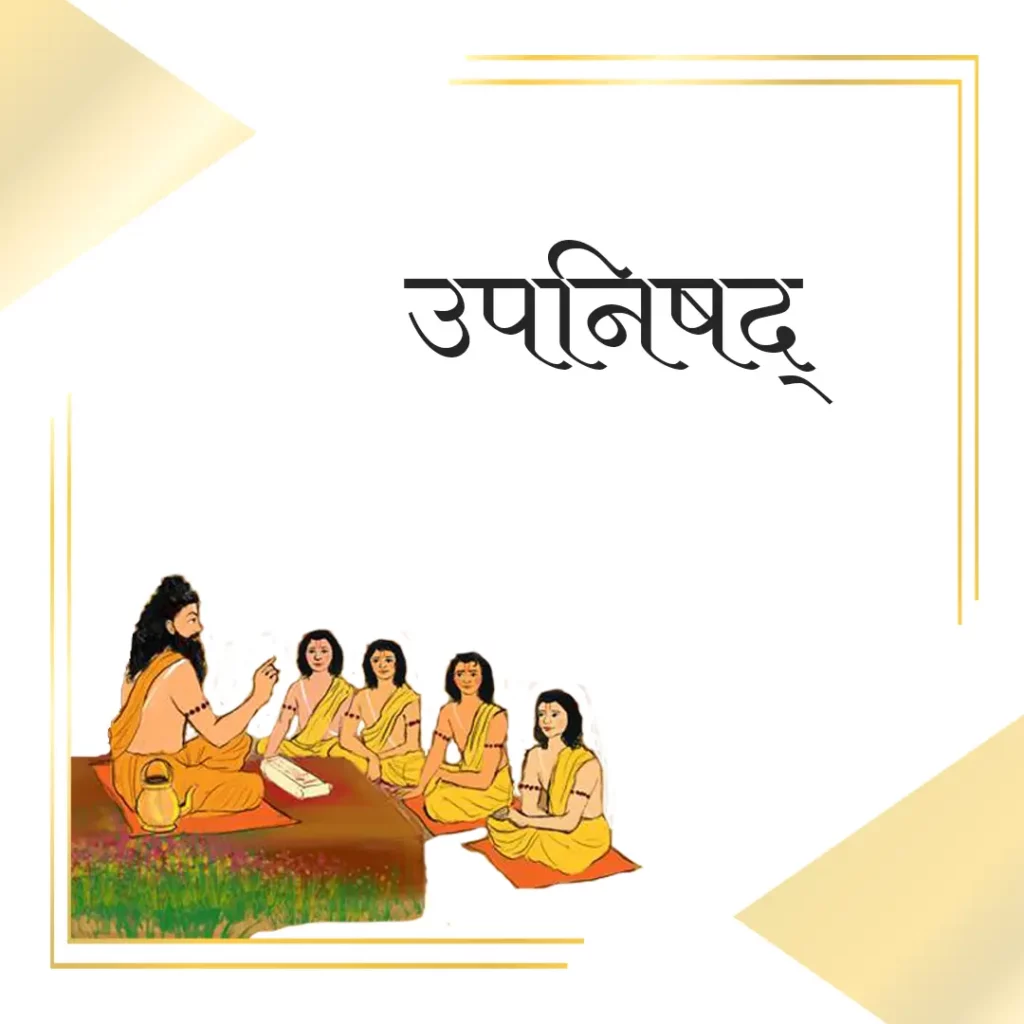Upanishad Information

उपनिषद शब्द का अर्थ | उपनिषद का रचनाकाल | मुख्य उपनिषद् कितने है |
उपनिषदों का महत्व | Upanishad Information
उपनिषद (Upanishad Information) संस्कृत भाषा में लिखे गए वैदिक साहित्य यानि हमारे चार वेद के ही भाग है, और सनातन धर्म के अधिक महत्त्वपूर्ण श्रुति धर्मग्रन्थ हैं। उपनिषदों की कुल संख्या 108 हे, जो संस्कृत भाषा में गद्य – पद्य दोनों में हैं, परंतु मुख्य उपनिषद 10 हैं, और तीन उपनिषद प्रमाण कोटि में रखे गए है । उपनिषदों में ईश्वर, संपूर्ण सृष्टि का रचयिता एवं संचालक परमात्मा-ब्रह्म और आत्मा के स्वभाव और सम्बन्ध का बहुत ही तत्वज्ञानी और ज्ञानपूर्वक वर्णन कहा गया है। उपनिषदों की मूल शिक्षा ब्रह्म, जीव और जगत् को ज्ञान देना है।
भारतीय दर्शनों के मूल स्त्रोत उपनिषद् ही है, जिनमे वेदान्त, सांख्य, जैन धर्म और बौद्ध धर्म हो उपनिषद ही मूल स्त्रोत है। उपनिषद को वेदान्त भी कहा जाता है। श्रीमद भगवद गीता, ब्रह्मसूत्र और उपनिषद् यह तीनो वेदान्त की ‘प्रस्थानत्रयी’ कहा जाता है। आचार्य अपनी प्रतिष्ठा के लिए सर्वप्रथम इन तीनो पर अपना भाष्य लिखते थे। आदि गुरु शङ्कराचार्य, रामानुज आदि महागुरुओ ने ऐसा कर के ही भली- भाँति ज्ञान दिया है। दर्शनशास्त्र जाननेवाला मनुष्य उपनिषद को अतिउत्तम ज्ञानकोश मानते है।
उपनिषद (Upanishad Information) साहित्य भारत की समग्र दर्शनशास्त्र संबंधी चिन्तनधारा का मूल स्रोत माना गया है। उपनिषद् की दर्शन सखाओ में ‘वेदान्त दर्शन’ अकेला सम्प्रदाय मुख्य है। भारतीय दर्शन के अतिरिक्त धर्म और संस्कृति पर उपनिषदों के तत्त्वज्ञान और कर्तव्यशास्त्र का प्रभाव स्पष्ट रूप से दिखाई पड़ रहा है।
उपनिषद का अर्थ:-
उपनिषद का सामान्य अर्थ है समीप बैठना जैसे की विद्या प्राप्त करने के लिए शिष्य का गुरु के पास बैठना होता है। उपमिषाद में उप’, ‘नि’ उपसर्ग तथा, ‘सद्’ धातु से उत्पन्न हुआ है। उपनिषद शब्द का अर्थ उप- निकट, निः – श्रद्धा और सद् – बैठना यह तीनो के संयोजन से बना उपनिषद। उपनिषद् में गुरु और शिष्य के बीच बहुत ही सुन्दर और जटिल वृत्तांत है जो सामान्य व्यक्ति को वेद के मर्म तक पहुंचाने मदद होती है। शिष्य का गुरु के पास बैठने से अविद्या का नाश होकर ब्रह्म विद्या की प्राप्ति होती है।
उपनिषद के ‘सद्’ शब्द के तीन अर्थ होते है, जो निम्नलिखित है।
1) विशरण यानि विनाश होना,
2) गति यानि ज्ञान प्राप्ति और
3) अवसादन यानि शिथिल होना।
इन तीनो का अर्थ को आदि शंकराचार्य ने उपनिषद को ब्रह्मविद्या कहा हे, जिसे जानकर मनुष्य को मोक्ष की प्राप्ति हो जाती है।
निहत्यानर्थमूलं स्वविद्यां प्रत्यक्तया परं।
नयत्यपास्तसम्भेदमतो वोपनिषद् भवेत् ।।
अर्थ:
जो अर्थहीन को उत्पन्न करनेवाली अविद्या को पूर्ण रूप से ध्वस्त करके दूर करता है, फेंकता है तथा छिन्न-भिन्न करता है, उसे उपनिषद् कहते हैं ।
उपनिषद का रचनाकाल:-
श्रीराधाकृष्णन के अनुसार उपनिषदों पर आदि शंकराचार्य ने भाष्य किया हे, वह अत्यंत प्राचीन और मानने योग्य है। उपनिषद के निर्माण का समय हम पक्का नहीं कर सकते। उपनिषदों में प्रारंभ के हे, वह बौद्धकाल के पहले के और कुछ उपनिषद बुद्ध के पीछे के हैं, यह निश्चित रूप से कह सकते है। उपनिषदों का निर्माण वैदिक सूक्तों की समाप्ति और छठी शताब्दी के मध्यवर्ती काल में हो सकता है।
उपनिषदों का प्रारंभिक रचनाकाल 1000 ईस्वी पूर्व से लेकर 300 ईस्वी पूर्व तक का माना जाता है। कुछ उपनिषद का रचनाकाल 400 या 300 ई.पू. के है, जो बौद्धकाल के पीछे का माना जाता है। सर्वाधिक प्राचीन उपनिषदों को वेदों की मूल संहिताओं का अंश माना जाता है।
भौगोलिक परिस्थितियां सूर्यवंशी-चन्द्रवंशी राजाओं या ॠषियों के नाम और खगोलीय योगों के विवरण आदि प्राप्त होते हैं। उनके द्वारा उपनिषदों के रचनाकाल की सम्भावना अभिव्यक्त की जाती है।
मुख्य उपनिषद्:-
उपनिषदों में मुक्तिकोपनिषद् के अनुसार 108 उपनिषदों में से 10 उपनिषद मुख्य माने जाते है। यह 10 उपनिषदों में आदि शंकराचार्य ने बहोत ही महत्त्वपूर्ण भाष्य लिखा हुआ है। 10 मुख्य उपनिषद निम्नलिखित है।
1) ईशोपनिषद,
2) केनोपनिषद
3) कठोपनिषद,
4) प्रश्नोपनिषद,
9) छान्दोग्य उपनिषद और
ऋग्वेदीय – 10 उपनिषद
शुक्ल यजुर्वेदीय – 19 उपनिषद्
कृष्ण यजुर्वेदीय – 32 उपनिषद्
सामवेदीय – 16 उपनिषद्
अथर्ववेदीय – 31 उपनिषद्
उपनिषदों का महत्व :-
उपनिषदों में वेदों के गूढ़ ज्ञान को ॠषियों ने अपने जीवन-पर्यन्त अनुभव से निचोड़ कर सरल भाषा में लिखा गया है। उपनिषदों में ब्रह्म ज्ञान के बारे में विस्तरपूर्वक वर्णन किया गया है। इसमें ब्रह्म, मृत्यु, मोक्ष सहित कई प्रकार के भौतिक और आध्यात्मिक विषयों का वर्णन मिलता है। महाभारत के युद्ध में भगवान श्री कृष्ण ने अर्जुन के सारथि बनकर जो कार्य किया हे, उसी प्रकार वः कार्य उपनिषदों ने जन-जन के लिए किया है।
शास्त्रों और पुराणों के अनुसार चौरासी लाख योनियों से पार होकर तत्पश्चात मनुष्य जीवन प्राप्त होता है। फिर भी मुनष्य इसके मर्म को समझने का प्रयास नहीं करता है, और इसका उद्देश्य एक ही हे, सत्य का ज्ञान न होना। यह ज्ञान उपनिषदों में दिया गया है।
उपनिषदों में आत्मविद्या का ज्ञान मुख्य रूप से निरूपण किया गया है। इसमें ब्रह्म और आत्मा की प्राप्ति के साधन का निरूपण किया गया है। उपनिषदों में विद्या, अविद्या, आत्मज्ञान, मोक्ष, श्रेयस, प्रेयस, आचार्य आदि विषयो में चिन्तन किया गया है।
यह भी पढ़ें
नित्य कर्म पूजा प्रकाश हिंदी में
श्रीमद्भगवद्गीता का प्रथम अध्याय
Upanishad Information in English
The Upanishads (Upanishad Information) are part of the Vedic literature written in Sanskrit language i.e. our four Vedas, and are the more important Shruti scriptures of Sanatan Dharma. The total number of Upanishads is 108, which are in both prose and verse in Sanskrit language, but the main Upanishads are 10, and three Upanishads are kept in the evidence category. In the Upanishads, a very philosophical and knowledgeable description of the nature and relationship of God, the creator and operator of the entire universe, Paramatma-Brahman and the soul has been said. The basic teaching of Upanishads is to give knowledge to Brahman, Jiva, and the world.
Upanishads are the basic sources of Indian philosophy, in which Vedanta, Samkhya, Jainism and Buddhism are the Upanishads. Upanishad is also called Vedanta. Srimad Bhagavad Gita, Brahmasutra, and Upanishads, these three are called ‘Prasthanatrayi’ of Vedanta. Acharya used to write his commentary on these three first for his prestige. Adi Guru Shankaracharya, Ramanuja etc. Mahagurus have given good knowledge by doing this. People who know philosophy consider Upanishad as the best encyclopedia of knowledge.
Upanishad (Upanishad Information) literature has been considered as the basic source of the entire philosophical thought stream of India. ‘Vedanta Darshan’ is the only main school among Upanishad’s philosophy friends. Apart from Indian philosophy, the influence of Upanishad philosophy and ethics on religion and culture is clearly visible.
Meaning of Upanishad:-
The general meaning of the Upanishad (Upanishad Information) is to sit near like a disciple has to sit near the teacher to get knowledge. In Upanishad, ‘Up’ is derived from the ‘Ni’ prefix and ‘Sad’ metal. The meaning of the word Upanishad is up-near, NIH-faith, and sad-sitting, this Upanishad is made up of a combination of all three. The Upanishads have very beautiful and intricate narratives between the teacher and the disciple which help the common man to reach the heart of the Vedas. When the disciple sits near the Guru, Avidya is destroyed and Brahma Vidya is attained.
The word ‘Sad’ in Upanishad has three meanings, which are as follows.
1) Visharan means destruction,
2) speed i.e. attainment of knowledge and
3) Depression means relaxation.
Adi Shankaracharya has called the meaning of these three Upanishads as Brahmavidya, knowing which man attains salvation.
निहत्यानर्थमूलं स्वविद्यां प्रत्यक्तया परं।
नयत्यपास्तसम्भेदमतो वोपनिषद् भवेत् ।।
Meaning:
The one who completely demolishes, throws away, and disintegrates the ignorance that produces meaninglessness, is called Upanishad.
Composition of Upanishad: –
According to Sriradhakrishnan, Adi Shankaracharya has commented on the Upanishads, they are very ancient and worthy of acceptance. We cannot be sure of the time of the creation of the Upanishads. The earliest of the Upanishads, they pre-Buddhist times, and some Upanishads are post-Buddha, it can be said with certainty. The Upanishads may have been composed between the end of the Vedic Suktas and the middle of the 6th century.
The initial composition of the Upanishads is believed to be from 1000 AD to 300 AD. Some Upanishads were composed in 400 or 300 BC. K, which is believed to be behind the Buddhist period. The most ancient Upanishads are considered part of the original codes of the Vedas.
Geographical conditions, names of Suryavanshi-Chandravanshi kings or sages, and details of astronomical yogas, etc. are obtained. The possibility of the composition of the Upanishads is expressed by them
Main Upanishads:-
According to Muktikopanishad in Upanishads, out of 108 Upanishads, 10 Upanishads are considered main. Adi Shankaracharya has written very important commentaries on these 10 Upanishads. Following are the 10 main Upanishads.
1) Ishopanishad,
2) Kenopanishad,
3) Kathopanishad,
4) Prashnopanishad,
5) Mundakopanishad,
6) Mandukyopanishad,
7) Aitareya Upanishad,
8) Taittiriya Upanishad,
9) Chandogya Upanishad and
10) Brihadaranyaka Upanishad.
Rigvedic – 10 Upanishads
Shukla Yajurvediya – 19 Upanishads
Krishna Yajurvediya – 32 Upanishads
Samvediya – 16 Upanishads
Atharvavedic – 31 Upanishads
Importance of Upanishads:-
In the Upanishads, the sages have written the esoteric knowledge of the Vedas in simple language by squeezing them from their life-long experience. In the Upanishads, the knowledge of Brahman has been described in detail. In this description of many types of physical and spiritual subjects including Brahma, death, salvation is found. In the war of Mahabharata, the work done by Lord Shri Krishna as the charioteer of Arjuna, the Upanishads have done the same work for the people.
According to scriptures and Puranas, after passing through eighty-four lakh births, a human life is attained. Yet man does not try to understand its meaning, and its purpose is only one, not to know the truth. This knowledge is given in the Upanishads.
In the Upanishads, the knowledge of self-knowledge is mainly formulated. In this, the means of attaining Brahman and Atman have been described. In the Upanishads, contemplation has been done on subjects like Vidya, Avidya, Self-knowledge, Moksha, Shreyas, Preyas, Acharya etc.



मुझे उपनिषदों को बड़े ही तार्किक ढंग से समझना है, जिससे मुझे संतुष्टि मिल सके, जो अभी तक नही मिली, उपनिषदों का संबंध में जो सुना था वो प्राप्त नही हो पा रहा है, क्षमा करें
Thanks